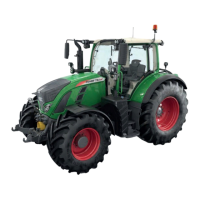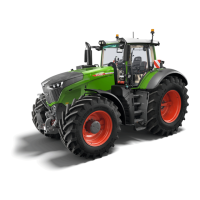4.2 Tires
4.2.1 Tire pressures
IMPORTANT:
Check tire pressures regularly!
Damage may occur if the correct tire pressure is not selected for the respective use.
General
The air pressure in the tire has a crucial function. The tire pressure affects the tire's load carrying capacity
and the ground pressure.
Incorrect tire pressures will damage the tire.
The tire pressure is dependent on:
• Wheel load
• Road speed
• Torque
These factors frequently change during day-to-day work. The tire pressure can be adjusted according to the
changing conditions using a tire pressure monitoring system.
Determination of the wheel load
The correct tire pressure can be set by weighing the actual wheel load:
1.
Transport position (road travel):
The tractor is weighed with implement and additional weights. The front-end weight and rear
implement are both raised (transport position). The tractor is weighed per axle.
2.
Working position (field use):
The tractor is weighed with implements and additional weights. The front-end weight is raised and the
rear implement is released (working position). The tractor is weighed per axle again.
NOTE:
The weighing process is the same for front-end implements.
3.
Front-end loader operation:
Weigh the tractor with lifted load and lifted additional loads per axle when the front-end loader is in
operation.
NOTE:
The permissible overall weight and permissible axle load must not be exceeded.
The wheel weight is the calculated axle weight divided by two.
Determination of tire pressure
Each tire manufacturer provides technical data (see table see Fig. 1 for example) for determining the
correct tire pressure. This information can be accessed online or requested from the tire manufacturer
directly.
IMPORTANT:
The information may differ between the tire manufacturers and the various tire sizes. For this reason,
always refer to the data for the type of tire that is actually being used.
4. TECHNICAL DATA
Maintenance 249
530.020.020.011 Rev.A

